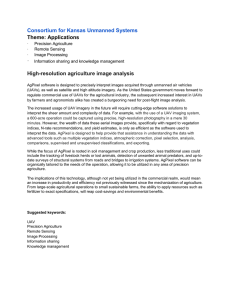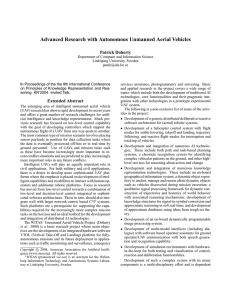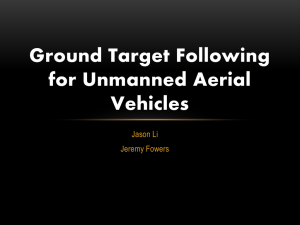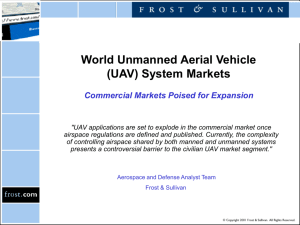International Journal of Application or Innovation in Engineering & Management... Web Site: www.ijaiem.org Email: , Volume 3, Issue 1, January 2014
advertisement
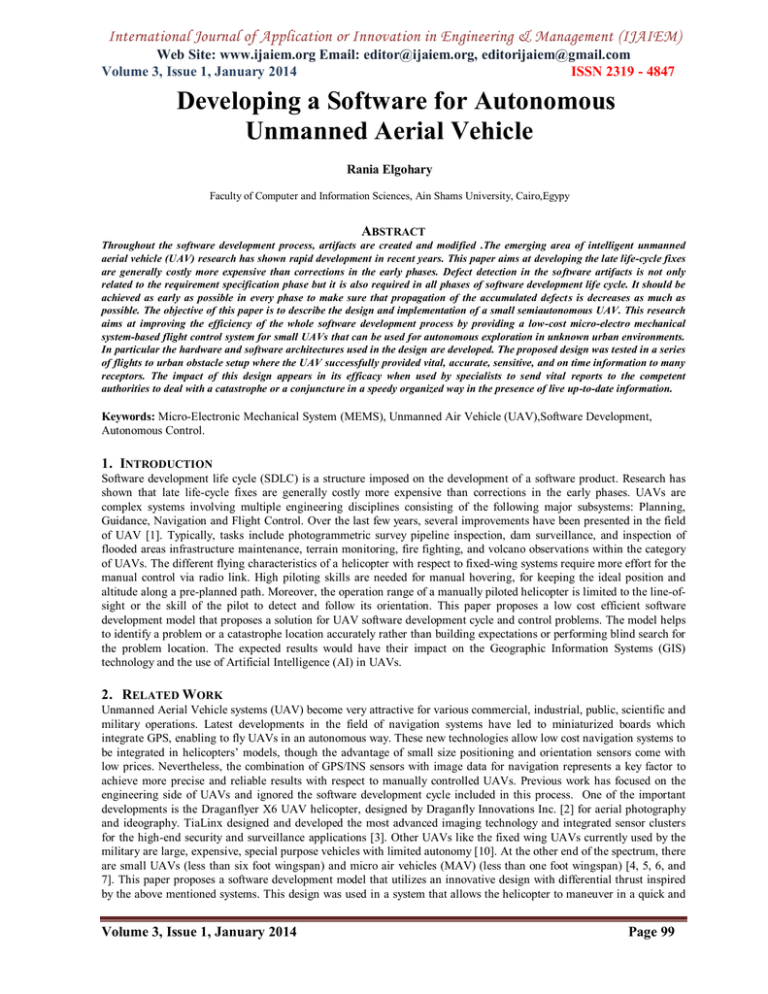
International Journal of Application or Innovation in Engineering & Management (IJAIEM) Web Site: www.ijaiem.org Email: editor@ijaiem.org, editorijaiem@gmail.com Volume 3, Issue 1, January 2014 ISSN 2319 - 4847 Developing a Software for Autonomous Unmanned Aerial Vehicle Rania Elgohary Faculty of Computer and Information Sciences, Ain Shams University, Cairo,Egypy ABSTRACT Throughout the software development process, artifacts are created and modified .The emerging area of intelligent unmanned aerial vehicle (UAV) research has shown rapid development in recent years. This paper aims at developing the late life-cycle fixes are generally costly more expensive than corrections in the early phases. Defect detection in the software artifacts is not only related to the requirement specification phase but it is also required in all phases of software development life cycle. It should be achieved as early as possible in every phase to make sure that propagation of the accumulated defects is decreases as much as possible. The objective of this paper is to describe the design and implementation of a small semiautonomous UAV. This research aims at improving the efficiency of the whole software development process by providing a low-cost micro-electro mechanical system-based flight control system for small UAVs that can be used for autonomous exploration in unknown urban environments. In particular the hardware and software architectures used in the design are developed. The proposed design was tested in a series of flights to urban obstacle setup where the UAV successfully provided vital, accurate, sensitive, and on time information to many receptors. The impact of this design appears in its efficacy when used by specialists to send vital reports to the competent authorities to deal with a catastrophe or a conjuncture in a speedy organized way in the presence of live up-to-date information. Keywords: Micro-Electronic Mechanical System (MEMS), Unmanned Air Vehicle (UAV),Software Development, Autonomous Control. 1. INTRODUCTION Software development life cycle (SDLC) is a structure imposed on the development of a software product. Research has shown that late life-cycle fixes are generally costly more expensive than corrections in the early phases. UAVs are complex systems involving multiple engineering disciplines consisting of the following major subsystems: Planning, Guidance, Navigation and Flight Control. Over the last few years, several improvements have been presented in the field of UAV [1]. Typically, tasks include photogrammetric survey pipeline inspection, dam surveillance, and inspection of flooded areas infrastructure maintenance, terrain monitoring, fire fighting, and volcano observations within the category of UAVs. The different flying characteristics of a helicopter with respect to fixed-wing systems require more effort for the manual control via radio link. High piloting skills are needed for manual hovering, for keeping the ideal position and altitude along a pre-planned path. Moreover, the operation range of a manually piloted helicopter is limited to the line-ofsight or the skill of the pilot to detect and follow its orientation. This paper proposes a low cost efficient software development model that proposes a solution for UAV software development cycle and control problems. The model helps to identify a problem or a catastrophe location accurately rather than building expectations or performing blind search for the problem location. The expected results would have their impact on the Geographic Information Systems (GIS) technology and the use of Artificial Intelligence (AI) in UAVs. 2. RELATED WORK Unmanned Aerial Vehicle systems (UAV) become very attractive for various commercial, industrial, public, scientific and military operations. Latest developments in the field of navigation systems have led to miniaturized boards which integrate GPS, enabling to fly UAVs in an autonomous way. These new technologies allow low cost navigation systems to be integrated in helicopters’ models, though the advantage of small size positioning and orientation sensors come with low prices. Nevertheless, the combination of GPS/INS sensors with image data for navigation represents a key factor to achieve more precise and reliable results with respect to manually controlled UAVs. Previous work has focused on the engineering side of UAVs and ignored the software development cycle included in this process. One of the important developments is the Draganflyer X6 UAV helicopter, designed by Draganfly Innovations Inc. [2] for aerial photography and ideography. TiaLinx designed and developed the most advanced imaging technology and integrated sensor clusters for the high-end security and surveillance applications [3]. Other UAVs like the fixed wing UAVs currently used by the military are large, expensive, special purpose vehicles with limited autonomy [10]. At the other end of the spectrum, there are small UAVs (less than six foot wingspan) and micro air vehicles (MAV) (less than one foot wingspan) [4, 5, 6, and 7]. This paper proposes a software development model that utilizes an innovative design with differential thrust inspired by the above mentioned systems. This design was used in a system that allows the helicopter to maneuver in a quick and Volume 3, Issue 1, January 2014 Page 99 International Journal of Application or Innovation in Engineering & Management (IJAIEM) Web Site: www.ijaiem.org Email: editor@ijaiem.org, editorijaiem@gmail.com Volume 3, Issue 1, January 2014 ISSN 2319 - 4847 accurate way. Furthermore, the GPS holds hands free function while the helicopter maintains its position in the air. Constant GPS readings are sent back to the handheld controller as part of the real-time telemetry display. 3 . THE PROPOSED MODEL AGCUAV The software design and the screen layout are based on operator experiences and customer demands for a self-explanatory environment, which allows monitoring all relevant UAV information and makes it easy to learn and memorize the UAV operation(s) for Autonomous Geographical control for unmanned Aerial vehicle AGCUAV. Mission planning is done by a graphical user interface, including moving map capabilities and waypoint editing by simple mouse clicks. The actual flight trajectory and the reference flight trajectory are both displayed on a map. Commands by the joystick or by the waypoint mission planner will directly be uploaded to the flight controller and will be executed immediately [8]. The developed environment can be used to operate helicopters and fixed wing aircraft. Furthermore, the implemented operations can be used in many applications, such as aerial photography, aerial surveillance or many kinds of aerial inspection [9]. The identification of a catastrophe location accurately can lead to higher probabilities in saving people and other physical parties. The proposed model (AGCUAV) uses a small UAV that controls the plane from a distance through the use of a laptop to carry out critical tasks. The model also uses a Global Positing Systems (GPS) navigation to increase the capacity to control the plane by calculating the ratio of Coordinates from the Aircraft Accurately. In addition, the model uses a GIS, which consists of a map of the site where the plane flies to determine the optimum air way and identifies difficulties in order to avoid it with the help of the used hardware. This paper presents a comprehensive analysis of the content of UAV data utilized in a multi-layer architecture model of 2D flight situation. Moreover, the paper describes the virtual instrument interface design that reflects the basic method of GUI (Graphical User Interface), and discusses the Ground Control Station (GCS) for Autonomous UAV Architecture. 3.1 GCS for autonomous UAV architecture UAV has typically been used in civil and military fields all over the world. Based on the UAV mission of autonomous flight, GCS including hardware and software, becomes important equipment to be developed. A well functioning GCS should consist of three parts: a portable ground station hardware system, a virtual instrument panel for the attitude information and flight path showing all kinds of error alert. Through the whole test on the ground and in the sky, GCS can show the remote sensing information precisely and send the control command in time. This can be used later to assist in the function of autonomous cruise task for UAV. The proposed model consists of three main modules in figure 1. The first module is the interface, which actually comprises two interfaces: (a) GCS System shown in figure 1: used for control on the plane by establishing interface design as the gadgets in the cabin crew on real planes to make controlling planes much easier to use; (b) GIS: creates a map to the enterprise location and creates this map in much detail to define the conjuncture location and the plane coordinates easily. The second module is the data collection, which is concerned with managing the collection of data from the instruments as cameras that collect data about conjuncture location and GPS that collect data about the coordinates, airway, and angle of the plane. This data is used to enrich the software by adding/updating data. The third module is the instrument, which is an encapsulation of all of the instruments used to collect raw data the developed system would have the ability to provide video images through the use of a variety of cameras, including high resolution digital still camera, high definition video camera, low light high resolution black and white video or an infra red camera. The system should also be designed with controls that ease its use and with a very minimal training. It should also provide an extremely stable aerial platform that aids to capture photographs and videos. Finally, a remote controller was required to control a battery operated helicopter that can be equipped with a high resolution still camera (with remote zoom, shutter control and tilt), high definition video, and low light black and white video or infrared camera. This model defines the required instruments, their tasks and the interaction between them. This model is integrated in the framework shown in figure 2. Figure 1 The architecture of GCS model Volume 3, Issue 1, January 2014 Page 100 International Journal of Application or Innovation in Engineering & Management (IJAIEM) Web Site: www.ijaiem.org Email: editor@ijaiem.org, editorijaiem@gmail.com Volume 3, Issue 1, January 2014 ISSN 2319 - 4847 Figure 2 The system framework 4. THE PROPOSED SYSTEM COMPONENTS DEVELOPMENT 4.1 Hardware Development The proposed system in Figure 3 includes a highly-integrated wireless transmission links, which are lighter than traditional links. The flight control provides altitude hold control and GPS navigation based on gain scheduling proportional-integralderivative control. Flight tests to survey the grass quality of a large lawn show that the small UAV, which can fly autonomously according to a series of pre-arranged waypoints with a controlled altitude while the wireless video system transmits images of the surveillance target to GCS. All devices used in the proposed system are developed as The Cam and sound sensor with transmitter and receiver UAV vision, the digital video recorder (DVR), AV receiver, the devices used in the plane control, and all the devices used in the plane control, Electro-gyroscope, Three-ax accelerometers and the Global Positioning System (GPS) provided long term stability with high accuracy. The coordinates that denote the location of an infestation was identified via a satellite circling the earth and transmitting signal called a pseudo random code. Each signal was encoded with information used to determine a receiver’s location. The signal transmission included the time the signal was sent and the satellite’s location in space. Moreover RADAR SYSTEMS is developed where the radiated power is largely dependent on the antenna aperture. Increasing the radiated power will increase the range of the radar but unless it is accompanied by LPI it will also announce the presence of the radiating aircraft to sensors on another one that still does not have you in its radar range. Figure 3 Hardware Phase\control\Display Systems This paper emphasizes three parts to build a well-functioning GCS: a portable ground station hardware system, a virtual instrument panel for the altitude information and flight path showing all kinds of error alert. Through the whole test on the ground and in the sky, GCS shows the remote sensing information precisely and sends the control command in time. Table 1shows the related technical specifications. Table 1: The Technical specifications of the helicopter model. Max Speed Max Flight Range Max High Max Takeoff Weight Battery Life Volume 3, Issue 1, January 2014 40 km/h 50 m 30 m 300gm 15 min Page 101 International Journal of Application or Innovation in Engineering & Management (IJAIEM) Web Site: www.ijaiem.org Email: editor@ijaiem.org, editorijaiem@gmail.com Volume 3, Issue 1, January 2014 ISSN 2319 - 4847 4.2 The Software Development The verification and validation processes are an essential and integral part of the software development process. Many Software Quality Assurance SQA standards have set guidelines for these processes. The software testing in this paper can be offers verification of the software under test and its validation at several levels. The complexity of software projects is increasing rapidly and in turn both cost and time of the testing process have become a major proportion of the software development process. The functional requirements of the proposed model AGCUAV, in the context of the current research work, are Feature Detection: this includes detecting the predominant features such as corners, edges and blobs in an image and generating a feature descriptor associated to each feature, Feature Matching: matching the features between successive images and generate the correspondence set, Compute Motion Parameters :vehicle (or camera) motion is computed from the correspondence set to generate the homograph matrix containing the six state parameters (position and orientation) of the vehicle. Predict and Correction: this involves predicting and correcting the next state parameters of the vehicle to steer the vehicle to the desired trajectory. The correction is essential as errors may get accumulated in the due course of time during navigation from one way-point to the other. The prediction and the correction are achieved using a state estimator or a navigational filter resulting in reaching the destination via (known) way-points. These functional requirements are illustrated in details in Figure 4. Figure 4 represents the steps of the system workflow between system actors, control station system specialist and GPS & GIS specialist The workflow of this system is illustrated as follows: the system owner finds conjuncture in any location in his area work when he finds this he must request a report for altitude problem from the control station system specialist to send an report to the system owner about the altitude problem. The control station system specialist needs to define the conjuncture location position from GIS & GPS specialist to send a plane (UAV) to the conjuncture location accurately. When the GIS & GPS specialist defines the conjuncture location then he sends it to control station system specialist to define the distance, height, and other things in flight operations. The control station system specialist needs to define airway from GIS (maps) for the work area to starting takeoff. The working between the control station system specialist and the GPS & GIS specialist is parallel. Finally, when the plane arrives to the conjuncture location, the control station system specialist records a video about the conjuncture location. Then the control station system sends this video to the system owner to send human agent to handle this problem. Computer-based testing can be classified into six levels according to its testing objectives, each of which focuses on a particular class of errors. The following is a discussion of these levels and their corresponding test objectives in both hardware and software testing. The scope of activity diagrams is individual use cases. Checking the consistency of activity diagrams with the specifications is out of the paper’s scope. 4.3 Hardware Testing and Development This section explains how one simulates and improves the hardware problems. For this purpose, a UAV helicopter with a remote control and a computer with maximum weight of takeoff were used. The aircraft was supported with helium balloon system, So two balloons were installed, one in front of the plane, and the second in the back of the plane where the installation of a column of carbon fiber was placed down the plane. The installation of the camera was on the top of carbon fiber for clarity of the vision. The use of the balloon helped to reduce the weight of the aircraft due to high balloon filled with helium gas, light weight. This modified the efficiency of the engine and provided the torque in the plane take off and the flight operation is increased. Moreover, for the flight stability and balance the weight of UAV was reduced as mentioned above. For the sensitivity of transaction in UAV, an R-2R Circuit was designed in order to convert digital signals to electrical power. 4.4 Software testing and development This paper improves the quality of the verification and validation V&V processes by enhancing the performance and efficiency of the testing process through automating the test cases generation process. The V&V processes play a tremendous role in improving the overall quality of the software. The proposed model presents an architecture that creates from activity diagrams a special table and a directed flow graph that are used in conjunction with the category partition method to generate a final reduced set of test cases. The generated test cases can be sent to any requirements management tool to be traced against the requirements. Experimental evaluation is presented to prove that the model saves time, space and consequently cost, improving by that the overall performance of the testing process. It is therefore imperative to reduce the cost and improve the effectiveness of software testing by automating the testing process. The testing effort is divided into three parts: test case generation, test execution, and test evaluation. 5. SIMULATION SCENARIOS This section presents results of both simulation and hardware tests. The scenario consists of a small autonomous ground vehicle operating on level ground; while a ground vehicle driving on a flat surface has the navigation system was performing. The following scenario would occur: When a conjuncture occurs, the UAV will fly to the location of Volume 3, Issue 1, January 2014 Page 102 International Journal of Application or Innovation in Engineering & Management (IJAIEM) Web Site: www.ijaiem.org Email: editor@ijaiem.org, editorijaiem@gmail.com Volume 3, Issue 1, January 2014 ISSN 2319 - 4847 conjuncture the system records the place then sends it back to the GCS system .This enlightens the rescue team and helps them to be more prepared. This paper presents a system able to provide vital information (accurate, sensitive and on time) to many receptors. This will allow the specialists to send vital reports to the competent authorities to deal with the catastrophe or the conjuncture in a very speedy way. CONCLUSION This paper presents the software development life cycle of a low-cost autonomous helicopter model called “AGCUAV”. The paper illustrates the development and testing of each cycle. Fixing faults early in the development process are much more cost effective than trying to consider those defects in the later cycles of the development process. The presented model AGCUAV provides a low cost solution for autonomous control challenges that helps the end user to do his task in an easy and efficient way. The AGCUAV model shares limitations with most computer embedded systems: limited space, limited power resources, increasing computation requirements, complexity of the applications, and time to market requirements. The proposed AGCUAV model orbits around four key elements: enhanced hardware architecture, a service/subscription based software architecture and an abstraction communication layer. This improved system may be use by specialists to send vital reports to the competent authorities to deal with the catastrophe or the conjuncture. The work done in this paper can be extended by adding high quality hardware, such as thermostat and sensitive detection of explosives that are sensitive to smoke, auto-piloting and autonomous adaptation to unexpected events are suggested. References [1] Beard, D. Kingston, M. Quigley, D. Snyder, R. Christiansen, W. Johnson, T. McLain: Autonomous Vehicle Technologies for Small Fixed-Wing UAVs. Journal of Aerospace Computing, Information and Communication, Vol. 2, 2005. [2] Gibralta.E: DRAGANFLY - RC/UAV with Infra-Red & HD Video. SteelMac Limited, Unit 27 New Harbors, 2010. [3] Brecher.A , V. Noronha and M. Herold.: Unmanned Aerial Vehicles (UAVs) in Transportation”, Specialist Workshop, 2005. [4] McCormackE.: Unmanned Aerial Vehicles: The Use of Small Unmanned Aircraft by the Washington State Department of Transportation”, Research report, Agreement T4118, Task 04, 2008. [5] Coifman.B, M. McCord, R. Mishalani and K.Redmill.: Surface Transportation Surveillance from Unmanned Aerial Vehicles in Proceedings of the 83rd Annual Meeting of the Transportation Research Board, 2004. [6] Eisenbeiss.H.:A Mini Unmanned Aerial Vehicle (UAV): System Overview and Image Acquisition in International Workshop on Processing and Visualization using High-Resolution Imagery, 2004. [7] Seok.J, K. Ro, and L. Dong.: Lessons Learned: Application of Small UAV for Urban Highway Traffic Monitoring, 45th AIAA Aerospace Sciences Meeting and Exhibit, 2005. [8] Soon.J and C. Tomlin.:Design and Implementation of a Low Cost, Hierarchical and Modular Avionics Architecture for the DragonFly UAVs, Proceedings of AIAA Guidance, Navigation, and Control Conference, 2002. [9] Zelinski.S, T. Koo and S. Sastry.: Hybrid System Design for Formations of Autonomous Vehicles in IEEE Conference on Decision and Control, 2003. [10] Anderson.E, Beard.R, and McLain.T.: Real Time Dynamic Trajectory Smoothing for Uninhabited Aerial Vehicles in IEEE Transactions on Control Systems Technology, 2005. [11] Rudek.R, Rudek.A, Skworcow.P.: An optimal sequence of tasks for autonomous learning systems.: in 16th International Conference on Methods and Models in Automation and Robotics (MMAR), 2011. Volume 3, Issue 1, January 2014 Page 103
